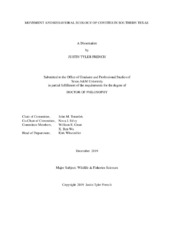| dc.description.abstract | Coyotes (Canis latrans) are a ubiquitous and successful predator species across North America. This success stems from their generalist diet, adaptable behavior, and cognitive abilities, and leads to many management and conservation issues. Despite a century of scientific research, effective coyote management practices remain elusive. This is caused, in part, by limited scientific understanding of the relationships between their behavior and their disease transmission, population dynamics, and effects on prey. These topics were difficult to study until the recent advent of GPS telemetry technologies and appropriate techniques to analyze the large, and complex data sets they produce. This work leverages these methodological advances to examine links between coyote movement behavior, sociality, disease transmission dynamics, population dynamics, and predator-prey relationships. I utilize recent advances in copula regression to examine the effects of carrion deposition on joint space use of coyotes, which is linked to contact rates in disease transmission models.
I then compare competing explanations of coyote social and dispersal behavior, and obtain a behaviorally informed estimate local emigration rate. Finally, I examine inter-individual variation in the dynamics of coyote activity cycles, utilizing a new adaptation of autocorrelation functions, to test a common assumption underlying studies of dynamic predator-prey interactions. I found that copula regression methods gave asymptotically unbiased estimates of changes in coyote interactions. This study also suggests that social perturbations caused by carrion availability may have impacts that last longer than the resource. I found that the common resident-transient paradigm of coyote sociality is insufficient. The results of this work suggest that biding is an important dispersal behavior that influences coyote population dynamics, and that 88% of adult, territorial coyotes disperse annually. Finally, coyote activity cycles were more dynamic than previous work suggests. Activity was consistently acyclic across individuals in winter. Cycles were strongest in summer, but individuals diverged between crepuscular and nocturnal behavior. This work carries implications for the study of predator-prey dynamics in a landscape of fear context, suggesting not only are predator activity patterns seasonally dynamic, but the population average of activity cycles may be a poor predictor of risk to a given prey species. Overall, these three studies suggest that researchers should exercise caution with simplistic assumptions of coyote behavior. A more detailed understanding of both behavioral processes, and their implications is necessary to achieve effective strategies for managing coyote impacts. | en |


